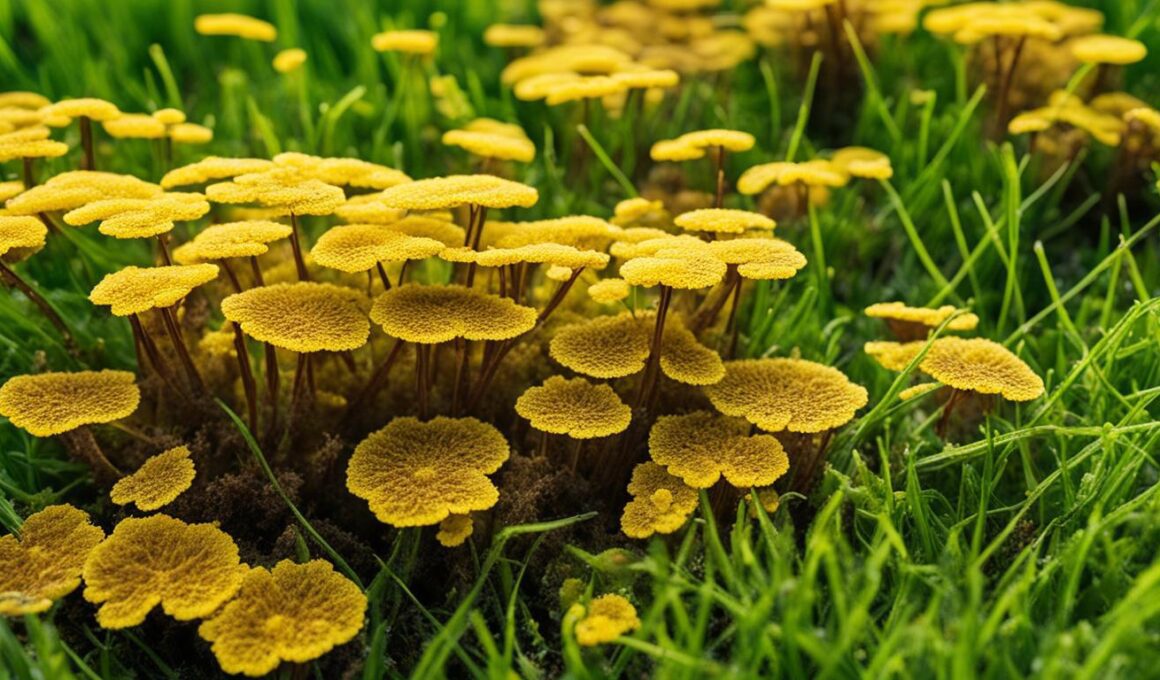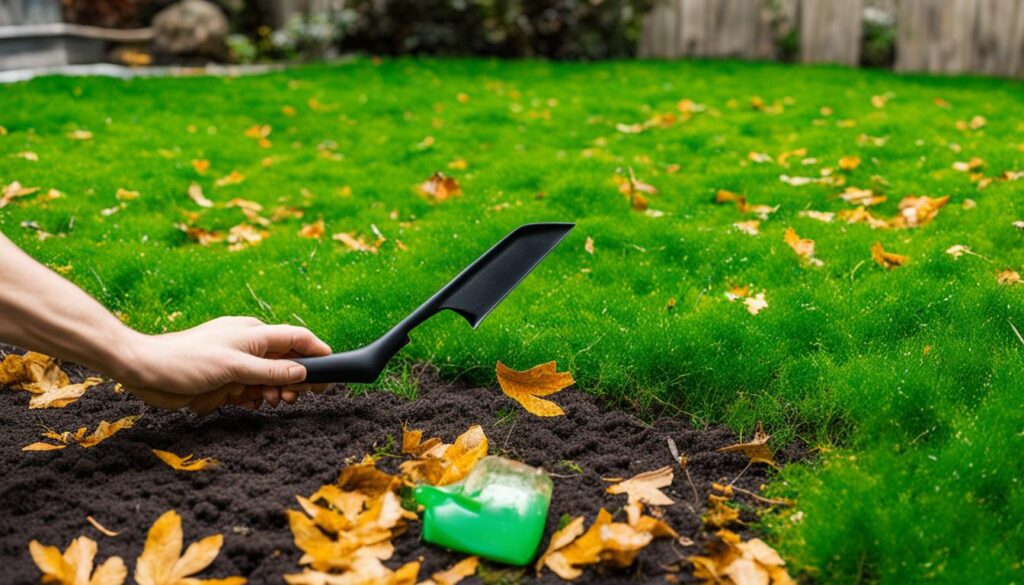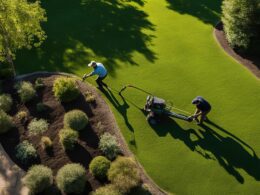Slime mold on grass is a common problem that many homeowners face. These primitive fungi can appear as a slimy, creamy-white or black substance on lawns, especially in moist and warm conditions. While they are not harmful to the grass itself, slime molds can be unsightly and unnerving. They feed on dead and decaying matter, which can actually benefit your lawn, but they also leave spores behind that generate future slime mold. In this article, we will provide tips to help you prevent and treat slime mold on your grass.
Key Takeaways:
- Slime mold on grass is not harmful to your lawn, but it can be unsightly.
- Slime molds use living turfgrass plants for structural support.
- They appear as a slimy, creamy-white or black substance in moist and warm conditions.
- Slime mold feeds on dead and decaying matter, which can benefit your lawn.
- Preventing slime mold growth involves proper lawn care practices and mechanical means of removal.
What is Slime Mold on Grass?
Slime mold on grass is not a true fungus, but it can appear on lawns in the form of thin, white, yellow, or gray layers of slimy paste-like substance covering leaf blades. It can also appear as a blue or orange crust-like substance. Slime mold on grass is not harmful to humans or pets, but it can be unsightly and reduce the rate of photosynthesis in grass.
The best conditions for slime mold to form are where there is plenty of organic material or a thick thatch, moderately moist soil, cool nights, and warm days. Slime mold on grass is not a sign of poor lawn care but rather a natural occurrence that can happen in any type of lawn.
Causes of Slime Mold on Grass
Slime mold on grass is caused by a combination of environmental factors. The most common cause of slime mold growth on grass is warm, wet weather. When wind drives slime mold spores onto grass, they deposit and settle. If moisture is present in the grass, these spores bloom and reproduce, forming patches on the lawn.
Another contributing factor to slime mold growth is the buildup of organic matter in the lawn. This can include dead leaves, grass clippings, and other decaying plant material. When there is an excess of organic matter, slime mold has more food to thrive and multiply.
Poor drainage and heavy thatch can also create favorable conditions for slime mold. If water does not drain properly from the lawn or if there is a significant layer of dead organic material (thatch) on the surface, the excess moisture can create an ideal environment for slime mold growth.
Furthermore, certain lawn care practices can inadvertently promote the growth of slime mold on grass. Overwatering the lawn, especially during periods of high humidity, can contribute to slime mold growth. Lack of sunlight, usually caused by dense tree cover or tall structures, can create the damp conditions slime mold favors. Improper fertilization can also provide excess nutrients that slime mold thrives on.

Prevention and Treatment of Slime Mold on Grass
Preventing and treating slime mold on your grass can be accomplished through both chemical and mechanical means. While chemical control measures are usually not necessary, they may be used in severe or recurring cases. It’s important to note that fungicides should only be utilized sparingly and as a last resort, as they can harm beneficial organisms and the environment.
When it comes to mechanical means of removing slime mold, there are several options available. These include dethatching, mowing, raking, and brushing. Regular lawn care practices, such as proper mowing techniques, removing grass clippings, ensuring proper drainage, and reducing thatch buildup, can also play a crucial role in preventing the growth of slime mold on your grass.
Using mechanical means to remove slime mold not only helps eliminate the existing growth, but it also disrupts the conditions that promote its growth in the first place. By implementing consistent lawn care practices, you can create an environment that discourages slime mold development.
Note: It’s important to remember that prevention is key when it comes to slime mold on grass. Implementing proper lawn care techniques and maintaining good soil health can significantly reduce the chances of slime mold growth.
By taking proactive measures to prevent slime mold and utilizing mechanical means to address any existing growth, you can effectively manage this issue without the need for chemical treatments. This approach not only ensures the health and appearance of your lawn but also helps protect the environment.
Remember, maintaining a healthy and well-cared-for lawn is essential in reducing the likelihood of slime mold on grass. By following these preventive measures and employing mechanical means, you can enjoy a lush and slime-free lawn all year round.
Why You Should Hire a Professional to Remove & Prevent
When dealing with slime mold on grass, it’s important to consider hiring a professional for removal and prevention. Professional lawn care companies possess the expertise and experience necessary to properly identify and remove slime mold from your grass, while also implementing preventive measures to ensure it doesn’t return.
One of the advantages of hiring professionals is their access to specialized equipment and products specifically designed for effective slime mold removal. These professionals understand the unique characteristics of slime mold and are equipped with the right tools to eliminate it without harming beneficial organisms in your lawn.
By entrusting slime mold removal to professionals, you can save significant time and effort. Dealing with slime mold on your own can be a time-consuming task, involving research, trial-and-error, and the use of various products. Professionals streamline the process, allowing you to focus on other priorities in your life.
Moreover, hiring a professional for slime mold removal and prevention can lead to long-term cost savings. Professionals will implement preventive measures to ensure slime mold doesn’t reoccur, eliminating the need for expensive treatments or constant reapplication of products. They can also provide guidance on proper lawn care practices to maintain a healthy and slime mold-free lawn.
Overall, hiring a professional for slime mold removal and prevention offers many benefits, including their expertise, specialized equipment, time savings, and long-term cost savings. Ensure your lawn is in the hands of professionals who can provide the best treatment and removal of slime mold, while also preventing its return.
Benefits of Hiring a Professional for Slime Mold Removal
Here are the key advantages of hiring a professional for slime mold removal:
- Expertise in properly identifying and removing slime mold from grass
- Access to specialized equipment and products for effective removal
- Time savings by entrusting the task to professionals
- Long-term cost savings through preventive measures
- Assurance of proper treatment and prevention of slime mold
Conclusion
In conclusion, slime mold is a common occurrence on lawns and is generally regarded as harmless to grass and plants. While it may be unsightly, it does not cause long-term damage and can actually benefit your lawn by breaking down organic matter. Slime mold on grass is a natural and temporary phenomenon that can be managed and controlled.
To prevent slime mold on grass, it is important to practice proper lawn care. This includes regularly mowing your lawn at the appropriate height, removing grass clippings, and ensuring proper drainage to reduce excess moisture. Additionally, reducing thatch buildup and maintaining a healthy lawn environment can help deter slime mold growth.
If slime mold does appear on your lawn, there are mechanical means of removing it. This can include dethatching, raking, and brushing the affected areas. These methods can help physically remove the slime mold without the need for chemical treatments.
It is important to note that chemical treatments should only be used as a last resort and with caution. While there are fungicides available to control slime mold, they should be sparingly used due to the potential harm they may cause to beneficial organisms and the environment. It is always recommended to consult with a professional lawn care company for guidance on the appropriate and safe use of such treatments if necessary.
What Are the Similarities and Differences Between Slime Mold on Grass and Red Thread in Lawn?
Slime mold on grass and red thread in lawn both impact the appearance of the turf. However, the causes of red thread are fungal, while slime mold is a non-pathogenic organism. Red thread creates pinkish-red threads in the grass, while slime mold forms a slimy, sometimes colorful coating.
FAQ
Is slime mold on grass harmful to humans or pets?
No, slime mold on grass is not harmful to humans or pets.
What are the common causes of slime mold growth on grass?
The most common causes of slime mold growth on grass are warm, wet weather, organic matter buildup, poor drainage, and heavy thatch.
Can I use chemical treatments to control slime mold on grass?
Chemical control measures are not typically necessary but may be used in severe or recurring cases. However, they should be used sparingly and as a last resort due to their potential harm to beneficial organisms and the environment.
How can I prevent slime mold from growing on my grass?
Regular lawn care practices such as proper mowing, removing grass clippings, ensuring proper drainage, and reducing thatch buildup can help prevent the growth of slime mold on grass.
What are the benefits of hiring a professional to remove and prevent slime mold on grass?
Hiring a professional lawn care company can save you time and provide long-term cost savings by preventing the reoccurrence of slime mold. They have the expertise, experience, specialized equipment, and products to effectively remove slime mold without harming beneficial organisms.










